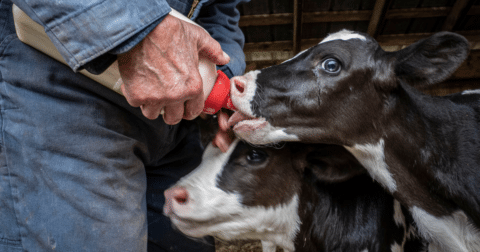News
Senate Finally OKs Plant-Based Milk in Public Schools
Policy•5 min read
News
Proponents for the bill hope to curb environmental pollution and bolster small dairy farms.

News • Factory Farms • Policy

Words by Gaea Cabico
In New York, the country’s fifth largest milk-producing state, lawmakers are taking aim at the rapid growth of massive dairy farms, in what environmentalists say is a crucial first step to addressing environmental and social impacts from these industrial facilities.
A new legislative measure, introduced by Assemblymember Linda Rosenthal and Senator Jabari Brisport, seeks to prohibit the state’s Department of Environmental Conservation (DEC) from permitting new large concentrated animal feeding operation (CAFOs) or approving the expansion of existing ones.
CAFOs are industrial-scale farms that confine up to hundreds of thousands of animals in tightly packed conditions. For dairy cows, CAFOs are defined as those housing 700 or more animals. The number of CAFOs in the United States has risen along with the cost of meat and dairy products.
New York is currently home to around 500 CAFOs, most of which are dairy farms. In 2023, there were 630,000 dairy cows on the 3,000 dairy farms in the state. Environmental group Food & Water Watch estimated that more than 425,000 cows were confined in mega-dairies across New York in 2022.
“In just 20 years, New York has doubled the number of dairy factories and over two-thirds of the state’s [family scale] dairies were shuttered,” Rosenthal, who represents Manhattan’s Upper West Side and Hell’s Kitchen neighborhoods, tells Sentient.
“We want to have some control over that,” she adds.
Assembly Bill 6928 and Senate Bill 6530 would bar the DEC from issuing new licenses for large CAFOs or allowing existing operations to expand into that category. Existing large CAFOs would not be shut down if the bill becomes a law.
“We’re not affecting those,” Rosenthal says, and dairy or other farms that aren’t CAFOs are also exempt. “If somebody or a family wants to open up a smaller farm, that’s fine,” she says.
Carolyn Dimitri, who teaches food studies at New York University, tells Sentient that preventing the expansion of CAFOs is a positive step for the local environment. “That will be good for our waterways, soil and air. I wish personally that more states would do that.”
Mega-dairies in New York generate 17.5 billion pounds of manure annually, which is equivalent to human sewage from 12.9 million people, or two-thirds of the state’s population. Each day, factory farms in the state produce enough manure to fill 11.5 Olympic-sized swimming pools.
“As mega-dairies have gotten bigger and bigger, and the whole industry has moved that way, you have way, way more manure,” Alex Beauchamp, Northeast Region director of environmental group Food & Water Watch, tells Sentient.
He notes that small-scale farms might be able to manage manure by applying it to nearby fields or their own crops as fertilizer. But it’s a logistical headache for operations housing thousands of animals.
“So you’ve got to store it somewhere, usually in a big open pit lagoon, and then you’ve got to haul it all over the state to eventually spread [it] over crops. All along the process, you have runoff into our lakes, river streams,” he adds.
Manure management systems of factory farms also produce carbon dioxide and methane—greenhouse gases that warm the planet.
For Beauchamp, the bill is a “very logical first step.”
“Let’s do something to bring the scale back down to a manageable level, not only for the environment, but also for family farmers as well,” he says.
Beyond environmental concerns, large CAFOs are also accelerating the decline of small-scale farms, proponents of the measure argue.
New York had about three times more small family dairy farms in 2002 than it did in 2022, according to Food & Water Watch. In a span of just five years — between 2017 and 2022 — the number of these farms dropped by 1,900.
“Big corporate entities are just taking over,” Rosenthal says.
Allyson Jones-Brimmer, vice president of regulatory and legislative affairs of the Northeast Dairy Producers Association, disagrees with Rosenthal’s characterization of larger dairies.
“Regardless of farm size, 95 percent of New York State farms are family-owned and our dairy cooperatives are predominantly owned by those family farms,” she said in a press conference on June 4 hosted by Republican legislators from upstate New York who are opposing the bill.
Placing a cap on the number of cows allowed in dairy farms, she added, “limits their opportunity for success.” According to the New York State Department of Agriculture, the dairy industry is the state’s largest agricultural sector and a major contributor to the local economy.
Jones-Brimmer also noted that dairy farms in the state are required to hire state certified third party professionals to develop management practices to help protect the environment.
NYU’s Dimitri, who is also an applied economist, argues that the scale of large CAFO operations in the state make it “economically difficult” for the small and mid-sized dairies to stay in business.
“If you value having small to medium scale agriculture in your state, then having a lot of large-scale CAFOs would sort of drive those operations out of business,” says Dimitri. At the same time, she noted the proposed legislation is “not a panacea” as these smaller farms will still face competition from factory farms in neighboring states.
Senator George Borrello, a ranking member of the Senate’s agriculture committee, also raised concerns at the press conference that agribusinesses would relocate to other states with weaker regulations and poorer standards.
Beauchamp doesn’t believe Borrello’s concern will play out in reality. “It’s not easy to just outsource all your dairy to some other state,” Beauchamp says, noting the farther a farm is from the processing facility, the more it costs to transport everything.
Beauchamp also believes that marketing the state as a place of local, small family farms will resonate more with consumers, particularly in New York City.
For Dimitri, an ideal dairy landscape in New York has farms that not only treat animals well but also provide a decent livelihood for farmers. But she acknowledges that, at the end of the day, consumer prices tend to shape how the food system and businesses are organized.
“I think a more reasonable goal is to have some farms that are operating to have very low priced products and other farms that are looking at environmental quality, worker well-being, farm well-being,” she says. “Somehow, they balance out and you have some variety in terms of price in the food system.”
The bill’s sponsors and Food & Water Watch recognize this is a “multi-year effort.” Rosenthal says she is working to get more sponsors and build momentum for the initiative.
New York is not the first state to try to regulate the growth of factory farms and their environmental impacts. In August 2023, Oregon Governor Tina Kotek signed a law that requires a multi-step process for water quality permitting for any new large-scale factory farms. An earlier version of the bill had proposed a moratorium on permitting new and expanding factory farms.
Yet Beauchamp calls the Oregon law a “partial victory,” and a blueprint for the future. “The sky hasn’t fallen. Everything is fine. There are, in fact, still dairy farms in Oregon. None of the kind of ridiculous scare tactic or messaging they’re using in New York,” he says. “If Oregon can do it,” Beauchamp adds, “we ought to be able to do it in New York.”